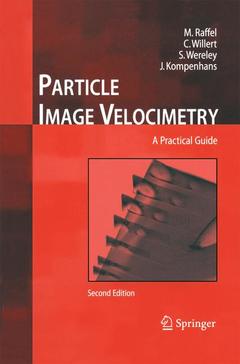Description
Particle Image Velocimetry (2nd Ed., 2nd ed. 2007)
A Practical Guide
Language: English
Subjects for Particle Image Velocimetry:
Particle Image Velocimetry (2nd Ed.)
Publication date: 12-2014
448 p. · 15.5x23.5 cm · Paperback
Replaced by new edition: Access to the new edition.
Publication date: 12-2014
448 p. · 15.5x23.5 cm · Paperback
Replaced by new edition: Access to the new edition.
Particle image velocimetry : a practical guide (Experimental fluid mechanics) (2nd Ed.)
Publication date: 08-2007
Support: Print on demand
Replaced by new edition: Access to the new edition.
Publication date: 08-2007
Support: Print on demand
Replaced by new edition: Access to the new edition.
Description
/li>Contents
/li>Comment
/li>
The development of Particle Image Velocimetry (PIV), a measurement technique, which allows for capturing velocity information of whole ?ow ?elds in fractions of a second, has begun in the eighties of the last century. In 1998, when this book has been published ?rstly, the PIV technique emerged from laboratories to applications in fundamental and industrial research, in par- lel to the transition from photo-graphicalto video recording techniques. Thus this book, whose objective was and is to serve as a practical guide to the PIV technique, found strong interest within the increasing group of users. The early progress made with the PIV technique might best be char- terized by the experience gained during our aerodynamic research at DLR (Deutsches Zentrum fur ? Luft- und Raumfahrt) at that time. The ?rst app- cations of PIV outside the laboratory, in wind tunnels, as performed in the mid-eighties were characterized by the following time scales: time required to set up the system and to obtain well focused photo-graphical PIV recordings was 2 to 3 days, time required to process the ?lm was 0. 5 to 1 day, time - quired to evaluate a single photo-graphicalPIV recording by means of optical evaluation methods was 24 to 48 hours. When the ?rst edition of this book was published in 1998, with electronic cameras and computers, it was pos- ble to focus on-line, to capture several recordings per second, and to evaluate a digital recording within seconds.
Physical and Technical Background.- Mathematical Background of Statistical PIV Evaluation.- PIV Recording Techniques.- Image Evaluation Methods for PIV.- Post-Processing of PIV Data.- Three-Component PIV Measurements.- Micro-PIV.- Examples of Application.- Related Techniques.
Well established book Important reference and textbook for industry, university and students Covers all major applications of PIV New, completely updated and enlarged edition Very comprehensive source for PIV developers and users
© 2024 LAVOISIER S.A.S.




